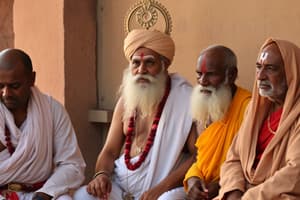Podcast
Questions and Answers
Which of the following best describes the religious element in the Indus Valley Civilization?
Which of the following best describes the religious element in the Indus Valley Civilization?
- It was completely absent, as it was a completely secular civilization.
- It was a mix of both secular and religious elements, with the religious aspect being more prominent.
- It was present but did not dominate the overall cultural landscape. (correct)
- It dominated the scene and was the focus of the civilization.
Which of the following was NOT a characteristic of religious practices in the Indus Valley Civilization?
Which of the following was NOT a characteristic of religious practices in the Indus Valley Civilization?
- Yoni worship
- Phallic (lingam) worship
- Worship of the sun god (correct)
- Zoolatry (animal worship)
According to the passage, what can be inferred about the representation of the male deity in the Indus Valley Civilization?
According to the passage, what can be inferred about the representation of the male deity in the Indus Valley Civilization?
- The male deity is described as being represented on a seal with three heads and three horns, in a sitting posture of a yogi, surrounded by various animals. (correct)
- The male deity was not surrounded by any animals or other figures.
- The male deity was depicted with a single head and no horns.
- The male deity was depicted in a standing posture, not in a yogic sitting posture.
What can be inferred about the Harappan script from the information provided in the passage?
What can be inferred about the Harappan script from the information provided in the passage?
According to the passage, which of the following best describes the Harappans' view of the Earth?
According to the passage, which of the following best describes the Harappans' view of the Earth?
What can be inferred about the development of goddess worship in the Indian subcontinent from the information provided in the passage?
What can be inferred about the development of goddess worship in the Indian subcontinent from the information provided in the passage?
Which of the following best describes the purpose of the amulets found in the Indus Valley Civilization?
Which of the following best describes the purpose of the amulets found in the Indus Valley Civilization?
What can be inferred about the role of tree worship in the religious practices of the Indus Valley Civilization?
What can be inferred about the role of tree worship in the religious practices of the Indus Valley Civilization?
What can be inferred about the development of village-level goddesses in the Indian subcontinent from the information provided in the passage?
What can be inferred about the development of village-level goddesses in the Indian subcontinent from the information provided in the passage?




